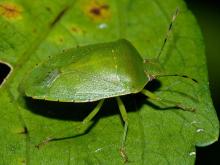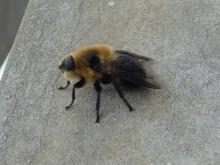Land Invertebrates
Media

Species Types
Scientific Name
Poecilopompilus algidus and P. interruptus
Description
Poecilopompilus spider wasps provision their nests with orbweaver spiders. They dig nest burrows into the ground and therefore prefer sandy or other workable substrates.
Media

Species Types
Scientific Name
Entypus aratus, E. unifasciatus, E. fulvicornis, and others
Description
Spider wasps in genus Entypus are bluish black and usually have some amount of amber color on their dark, smoky wings. Some species have bright yellow antennae.
Media

Species Types
Scientific Name
Chinavia hilaris (formerly Acrosternum hilare)
Description
The green stink bug is one of many species of stink bugs. Like others in their family, they emit a foul odor when they are harassed or crushed.
Media

Species Types
Scientific Name
Rabidosa punctulata
Description
The dotted wolf spider has a solid brown stripe running down the middle of the abdomen, seen from above. Like other wolf spiders, females have strong maternal instincts, carrying their spiderlings around on their back until they can be on their own.
Media

Species Types
Scientific Name
Tigrosa aspersa
Description
A speckled wolf spider usually seems larger than it actually is. It's one of Missouri's more common species of wolf spiders. Mothers have remarkable maternal instincts and are often seen carrying their young around on their abdomen.
Media

Species Types
Scientific Name
Rabidosa rabida
Description
The rabid wolf spider, despite its scary name, is harmless to people and is absolutely not rabid. It commonly hides in leaf litter and sometimes gets into houses.
Media

Species Types
Scientific Name
Scolia dubia
Description
The blue-winged wasp is a common Missouri species of scoliid wasp. The abdomen has a distinctive fuzzy, rich rusty patch with two ovals of yellow. Its larvae eat Japanese beetle grubs and other scarab beetle larvae.
Media

Species Types
Scientific Name
Scudderia furcata
Description
The fork-tailed bush katydid reaches about 1¾ inches long. It is usually leafy green and is most common in bushes, thickets, and other shrubby areas. It is most active after dusk. The call is a simple "tsip!" given every few seconds.
Media

Species Types
Scientific Name
About 40 species in North America north of Mexico
Description
Bot flies are chunky, beelike flies usually with rounded heads. Adults are not commonly seen. The larvae are short, pudgy, segmented grubs that live as parasites in the tissues of animals. Those that live just under the skin often form a bulge. Some types live in the nasal or throat cavities of deer.
Media
Species Types
Scientific Name
About 11 species in North America north of Mexico
Description
Mantidflies look like a cross between a lacewing insect and a praying mantis. They are small, delicate creatures with intricately veined wings, but the front half looks like a mantid, complete with raptorial forelegs.
See Also



Media

Species Types
Scientific Name
Cisseps fulvicollis
Description
The yellow-collared scape moth is more often “orange-collared.” And whether you think it looks more like a firefly or a wasp, it’s still a moth!
Media

Species Types
Scientific Name
Nearly 150 species in North America north of Mexico
Description
Slim, delicate plume moths are instantly recognizable by their T-shaped silhouette, long legs, and muted shades of tan and brown. It can be hard to separate the various species.
Media

Species Types
Scientific Name
Pyrrharctia isabella
Description
Not many people know the adult Isabella tiger moth when they see one, but we’re all acquainted with its caterpillar, the woolly worm, or woolly bear.
About Land Invertebrates in Missouri
Invertebrates are animals without backbones, including earthworms, slugs, snails, and arthropods. Arthropods—invertebrates with “jointed legs” — are a group of invertebrates that includes crayfish, shrimp, millipedes, centipedes, mites, spiders, and insects. There may be as many as 10 million species of insects alive on earth today, and they probably constitute more than 90 percent all animal species.





















